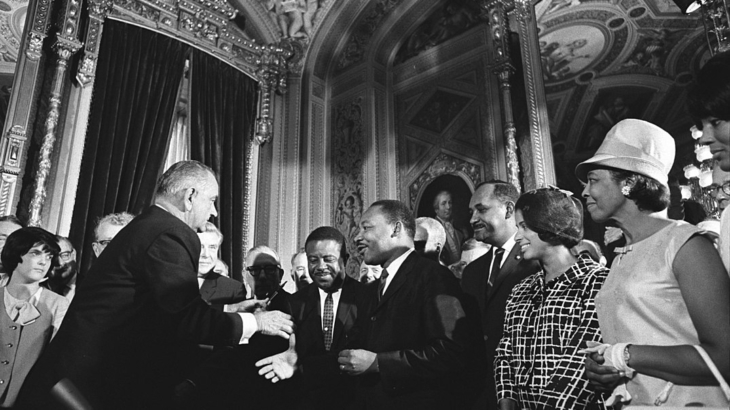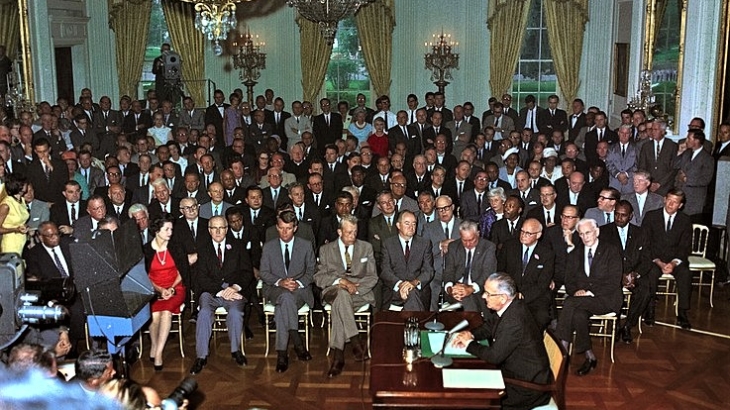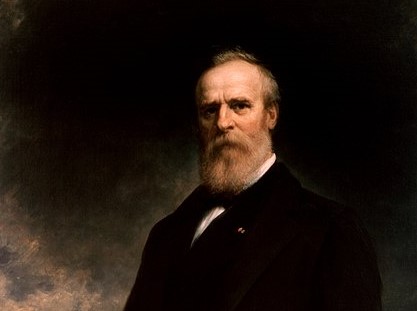It took almost a century for Congress, and President Lyndon B. Johnson, a Democrat from Texas, to enact the Civil Rights Act of 1964, putting America back on the side of defending the equality before the law of all U.S. Citizens. That act formally made segregation illegal. It legally required states to stop applying facially neutral election laws differently, depending on the race of the citizen trying to register and vote. If the Civil Rights Act of 1957 had raised expectations by showing what was now possible, the Civil Rights Act of 1964 again dramatically raised expectations to actual equal treatment by governments.
But the defenders of segregation were not yet done. They continued to pursue the “massive resistance” to integration that emerged in the year between Brown I and Brown II.[1] They continued to refuse to register black voters, to use “literacy” tests (which tested esoteric knowledge, rather than literacy) only to deny black citizens the chance to register, and to murder those who didn’t get the message.
Jimmie Lee Jackson was one such victim of last-ditch defiance. In February 1965, Jackson, an Alabamian church deacon, led a demonstration in favor of voting rights in his hometown of Marion, Alabama; as he did so, state troopers beat him to death. The Southern Christian Leadership Conference (in apparent coordination with the White House) responded by organizing a far larger march for voting rights, one that would cover the 54 miles from Selma, Alabama to the capitol in Montgomery. On March 7, 1965, that march reached the Edmund Pettis Bridge in Selma, where national and international television cameras captured (and broadcast into living rooms everywhere) Alabama state troopers gassing and beating unarmed demonstrators. When the SCLC committed to continuing the march, others flocked to join them. Two days later, as a federal court considered enjoining further state action against the demonstrators, a mob lynched James Reeb, a Unitarian minister from Boston who had flown in for that purpose.
Johnson Returns to Congress
Less than a week later, President Johnson had called Congress into a special session and began it with a nationally televised Presidential address to a Joint Session.[2] Urging “every member of both parties, Americans of all religions and of all colors, from every section of this country” to join him in working “for the dignity of man and the destiny of democracy,” President Johnson, the heavily accented man-of-the-South that Senator Richard Russell, a Democrat from Georgia, once had connived to get into the Presidency, compared the historical “turning point” confronting the nation to other moments “in man’s unending search for freedom” including the battles of “Lexington and Concord” and the surrender at “Appomattox.” President Johnson defined the task before Congress as a “mission” that was “at once the oldest and the most basic of this country: to right wrong, to do justice, to serve man.” The President identified the core issue – that “of equal rights for American Negroes” – as one that “lay bare the secret heart of America itself[,]” a “challenge, not to our growth or abundance, or our welfare or our security, but rather to the values, and the purposes, and the meaning of our beloved nation.”
He said more. President Johnson recognized that “[t]here is no Negro problem. There is no Southern problem. There is no Northern problem. There is only an American problem. And we are met here tonight as Americans — not as Democrats or Republicans. We are met here as Americans to solve that problem.” And still more:
“This was the first nation in the history of the world to be founded with a purpose. The great phrases of that purpose still sound in every American heart, North and South: ‘All men are created equal,’ ‘government by consent of the governed,’ ‘give me liberty or give me death.’ Well, those are not just clever words, or those are not just empty theories. In their name Americans have fought and died for two centuries, and tonight around the world they stand there as guardians of our liberty, risking their lives.
“Those words are a promise to every citizen that he shall share in the dignity of man. This dignity cannot be found in a man’s possessions; it cannot be found in his power, or in his position. It really rests on his right to be treated as a man equal in opportunity to all others. It says that he shall share in freedom, he shall choose his leaders, educate his children, provide for his family according to his ability and his merits as a human being. To apply any other test – to deny a man his hopes because of his color, or race, or his religion, or the place of his birth is not only to do injustice, it is to deny America and to dishonor the dead who gave their lives for American freedom.
“Every American citizen must have an equal right to vote.
“There is no reason which can excuse the denial of that right. There is no duty which weighs more heavily on us than the duty we have to ensure that right.
“Yet the harsh fact is that in many places in this country men and women are kept from voting simply because they are Negroes. Every device of which human ingenuity is capable has been used to deny this right. The Negro citizen may go to register only to be told that the day is wrong, or the hour is late, or the official in charge is absent. And if he persists, and if he manages to present himself to the registrar, he may be disqualified because he did not spell out his middle name or because he abbreviated a word on the application. And if he manages to fill out an application, he is given a test. The registrar is the sole judge of whether he passes this test. He may be asked to recite the entire Constitution, or explain the most complex provisions of State law. And even a college degree cannot be used to prove that he can read and write.
“For the fact is that the only way to pass these barriers is to show a white skin. Experience has clearly shown that the existing process of law cannot overcome systematic and ingenious discrimination. No law that we now have on the books – and I have helped to put three of them there – can ensure the right to vote when local officials are determined to deny it. In such a case our duty must be clear to all of us. The Constitution says that no person shall be kept from voting because of his race or his color. We have all sworn an oath before God to support and to defend that Constitution. We must now act in obedience to that oath.
…
“We cannot, we must not, refuse to protect the right of every American to vote in every election that he may desire to participate in. And we ought not, and we cannot, and we must not wait another eight months before we get a bill. We have already waited a hundred years and more, and the time for waiting is gone.
…
“But even if we pass this bill, the battle will not be over. What happened in Selma is part of a far larger movement which reaches into every section and State of America. It is the effort of American Negroes to secure for themselves the full blessings of American life. Their cause must be our cause too. Because it’s not just Negroes, but really it’s all of us, who must overcome the crippling legacy of bigotry and injustice.
And we shall overcome.
…
“The real hero of this struggle is the American Negro. His actions and protests, his courage to risk safety and even to risk his life, have awakened the conscience of this nation. His demonstrations have been designed to call attention to injustice, designed to provoke change, designed to stir reform. He has called upon us to make good the promise of America. And who among us can say that we would have made the same progress were it not for his persistent bravery, and his faith in American democracy.
“For at the real heart of [the] battle for equality is a deep[-]seated belief in the democratic process. Equality depends not on the force of arms or tear gas but depends upon the force of moral right; not on recourse to violence but on respect for law and order.
“And there have been many pressures upon your President and there will be others as the days come and go. But I pledge you tonight that we intend to fight this battle where it should be fought – in the courts, and in the Congress, and in the hearts of men.”
The Passage and Success of the Voting Rights Act
Congress made good on the President’s promises and fulfilled its oath. The Voting Rights Act, the crowning achievement of the Civil Rights Movement, was signed into law in August 1965, less than five (5) months after those bloody events in Selma.
The VRA would allow individuals to sue in federal court when their voting rights were denied. It would allow the Department of Justice to do the same. And, recognizing that “voting discrimination … on a pervasive scale” justified an “uncommon exercise of congressional power[,]” despite the attendant “substantial federalism costs[,]” it required certain states and localities, for a limited time, to obtain the approval (or “pre-clearance”) of either DOJ or a federal court sitting in Washington, DC before making any alteration to their voting laws, from registration requirements to the location of polling places.[3]
And it worked.
The same Alabama Governor and Democrat, George Wallace, who (on first losing re-election) had promised himself never to be “out-segged” again and who, on getting back into office in 1963, had proclaimed “segregation today, segregation tomorrow, segregation forever[!]” would win re-election in 1982 by seeking and obtaining the majority support of Alabama’s African Americans. By 2013, “African-American voter turnout exceeded white voter turnout in five of the six States originally covered by [the pre-clearance requirement], with a gap in the sixth State of less than one half of one percent;”[4] the percentage of preclearance submissions drawing DOJ objections had dropped about 100-fold between the first decade under pre-clearance and 2006.[5]
At long last, with only occasional exceptions (themselves addressed through litigation under the VRA), American elections were held consistent with the requirements of the Constitution and the equality before the law of all U.S. Citizens.
Dan Morenoff is Executive Director of The Equal Voting Rights Institute.
Click Here to have the NEWEST essay in this study emailed to your inbox every day!
Click Here to view the schedule of topics in our 90-Day Study on American History.
[1] Southern states might now be required by law to integrate their public schools, but, by and large, they didn’t yet do so. That would follow around 1970 when a pair of events forced the issue: (a) a University of Southern California football team led by O.J. Simpson drubbed the University of Alabama in the Crimson Tide’s 1970 home opener – so allowing Alabama Coach Bear Bryant to finally convince Alabama Governor George Wallace that the state must choose between having competitive football or segregated football; and (b) President Nixon quietly confronting the Southern governments that had supported his election with the conclusion of the American intelligence community that their failure to integrate was costing America the Cold War – they must decide whether they hated their black neighbors more than they hated the godless Communists. However ironically, what finally killed Jim Crow was a love of football and a hatred of Marxism.
[2] See, https://www.americanrhetoric.com/speeches/lbjweshallovercome.htm.
[3] Shelby County v. Holder, 570 U.S. 529, 133 S.Ct. 2612, 2620 and 2624 (2013) (each citing South Carolina v. Katzenbach, 383 U.S. 301, 308 and 334 (1966)); and at 2621 (citing Northwest Austin Municipal Util. Dist. No. One v. Holder, 557 U.S. 193, 202-03 (2009)), respectively.
[4] Id. at 2626.
[5] Id.





